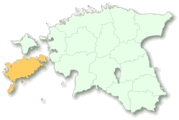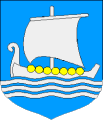 |
Sightseeing in Estonia. County of Saaremaa
|
|
The biggest island of Estonia, Saaremaa (area 2922 sq km, pop. about 40,000) is a well-know holiday spending place with peculiar nature and many sightseeings. Saaremaa succeeded to maintain its unique style primarily to its location and isolation. In the ancient villages you can still find buildings with cane roofs and stone fences; beautiful national customs and peculiar way of speech have been preserved. The most interesting sights of Saare County :1. Kuressaare Bishop Stronghold is probably the best-preserved medieval stronghold in all the Baltic States, being erected in the second half of the 13th century. In the center of the building from tooled dolomite bricks is a square courtyard, which is on the second and third floors surrounded by a closed cloister. There is an exposition of the Saaremaa Museum in the Stronghold that introduces the history and local nature of Saaremaa and Kuressaare. 2. The Town Hall - a Baroque building with a strict, simple and majestic form was built in 1670; the building was erected on the initiative of the Swedish big landowner Magnus Gabriel de la Gardie; the original look of the building was restored in the 1970-s; the Town Hall Gallery and Tourist Information are located here and there is a restaurant in the cellar. 3. The Old Town of Kuressaare - deriving from the 17-19th century has been nicely restored and full of sightseeings. It is one of the most beautiful town centers in Estonia. 
4. Vilsandi National Park of international importance, belonging to the highest category of the birds' reserves, has been derived from one of the first nature reserves of the Eastern Europe in the Islands of Vaika, established in 1910. In Vilsandi and the islets tens of thousands sea birds halt, feed and nest. 


5. Viidumäe Nature Reserve (1873 ha) was established in 1957 to protect rare species and associations of plants. Here is the only growing place in the world for the famous endemic species - Saaremaa yellow rattle; from other rarities mountain zigzag clover, whitebeam etc. can be found here. You can walk through the study track of 2km, starting from the center of the Reserve together with a guide. 
6. The Stronghold of Lihulinna with 2 ha courtyard and 6-8 meter walls is the mightiest of its kind and also the best-preserved stronghold in Saaremaa. The Stronghold is situated away from the forest, on the dunes, partly surrounded by marshes. 7. Angla Windmills are the most famous windmills of Saaremaa. The only windmill hill in Saaremaa that has retained its former look is situated in Angla, i.e. the highest point open to winds, where all the windmills of the village were built. In 1925, when there were 13 farmhouses in Angla, there were even 9 windmills here. From the five preserved windmills four are typical post windmills of Saaremaa, built in the beginning of the present century. Among them stands a bit taller Dutch mill, built in 1927. 8. Karja Katariina (Catherine) Church is the smallest medieval church in Saaremaa. The Church built in the 14th century has maintained its original look practically without any changes. Decorative ceiling paintings have been preserved partly in the Church; there are magic ceiling marks on the vaults of the choir room, over the vestry there is a unique room with a fireplace, the other fireplace is situated in the attic of the choir. Supposedly so the accommodation possibilities were created for the pilgrims, who traveled through the Scandinavia and the Island of Gotland to Maarjamaa. 

9. Üügu Bank is the most beautiful bank in Muhumaa. It is situated on the North-Western coast of the island, a bit afar from the current coastal line. The length of the steep cliff reaches up to 300 meters with the height of 12m over the seal level. 10. Eemu Windmill is a windmill built on the ancient site of windmills of the Eemu Farm, which acts as a Museum since May 17, 1980. The small windmills of the West-Estonia and islands are a peculiar phenomenon in the peasantry architecture, which has parallels only in Scandinavia and West-Finland. 
11. The Village of Koguva is the best-preserved village ensemble in Estonia (100 buildings, ca 20 permanent inhabitants). A unique milieu is created by the village streets with stone fences, log houses with cane roofs, old trees and draw wells with poles. All the buildings in Koguva date mainly from 1880 -1930. The oldest building of Koguva - the barn of the Andruse Farm - is situated in the center of the village. The only tool used in erecting of this building was an axe. The Center of the Village is the Tooma Farm - the home of the Writer Juhan Smuul. 
12. Panga Bank is the highest of the banks of the Northern coast of Saaremaa and Muhu. The maximum height of the Bank is 21.3m and the reach about 2.5km. In the highest point of the Bank an ancient sacrifice place is situated, where sacrifices to the sea were made in the old times. 

13. Valjala Church is the oldest building in Saaremaa, deriving from the first half of the 13th century. The Church has been built in the Romanesque and Gothic styles. In the masonry of the tower numerous archaic fragments of burial plots can be found. Gravestones of this shape have only been found in the West-Estonia. At least some of them should date back to the old times. 
14. The Field of the Kaali Meteorite Craters in Central Saaremaa is the rarest nature remembrance in Estonia, being at the same time also the most impressive field of craters in Eurasia. The biggest crater has a diameter of 110m and is 16 meters deep. There are eight craters found in the surrounding area. The Kaali Meteorite is the last (ca 7500 yrs ago) giant meteorite fallen to the densely inhabited area in the world. 15. Karujärv is the oldest lake in Saaremaa, which was formed about 8000 years ago. The area of the lake is ca 330 ha and the biggest depth - 6m. There are five islands in Lake Karujärv. According to a legend the lake got its name from being a fighting place of seven bears. To separate the bears God let it rain so hard that a lake was formed. The bears left, each in different direction and therefore the lake has seven crooks. 16. Ruhnu Island (area 11.4 sq km, ca 60 inhabitants) is the farthest island of Estonia. The distance to the Cape of Kolka on the coast of Latvia is 37km, 70km to Kuressaare. The Island of Ruhnu was first mentioned in 1341 in the Freedom Letter of the Bishop of Kuramaa, which constituted that the Swedes inhabiting the Island could lead a life of the free peasants. The wooden Church of Ruhnu, built in 1644, is one of the oldest wooden buildings in Estonia. One of the deepest bores is located on the Island of Ruhnu - 787.4m, the water coming out of which is of healing purposes and very salty. There are many rare species of plants and animals under protection on the Island. 



17. The Sõrve lighthouse (1960) on Saaremaa can be found on the southernmost tip of Sõrve peninsula. Sõrve has a unique and bloody history. Here the Nazis fought bitterly against the Soviets to maintain their last stronghold in Estonia in WWII. The remains of the military complex built by the Soviets can still be seen here. |
Fatal error: Uncaught Error: Call to undefined function mysql_connect() in /data03/virt15346/domeenid/www.aviastar.org/htdocs/travel/estonia/saaremaa.php:218 Stack trace: #0 {main} thrown in /data03/virt15346/domeenid/www.aviastar.org/htdocs/travel/estonia/saaremaa.php on line 218 |






